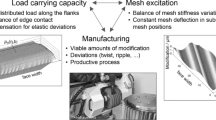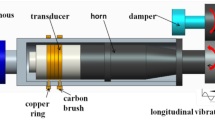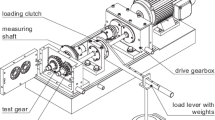Abstract
The surface structure of gear flanks has an impact on the performance of the gear mesh. Especially clearly visible structures are often expected to severely influence noise behavior. However, the evaluation proves to be difficult. Gears produced by skiving have a particular surface structure that is different from hobbed gears. Skiving is a continuous cutting technology for rotational symmetric and periodic structures. It is a very productive manufacturing process that can be used for internal and external gears. Soft machining as well as gear finishing is possible. This leads to increased use of skiving in gear production and the requirement to characterize the resulting flanks.
Standard modifications and periodic flank modifications will lead to low noise excitation. On a smaller scale, even the traces of the tooling from the manufacturing process have an impact on gear noise. The present study offers a geometrical approach to derive the microstructure of the flank surface from the skiving process. The effects of machining parameters on the microstructures are analyzed and the impact on noise is discussed.
Zusammenfassung
Die Oberflächenstruktur von Zahnradflanken beeinflusst die Performance von Zahnrädern. Deutlich sichtbare Strukturen wirken sich häufig deutlich auf das Geräuschverhalten aus. Die Beurteilung ist allerdings herausfordernd. Die charakteristische Oberflächenstruktur der Zahnflanken beim Wälzschälen unterscheidet sich vom Wälzfräsen. Wälzschälen ist ein produktives, kontinuierlich spanendes Herstellungsverfahren für rotationssymmetrische und periodische Strukturen, welches sowohl für Innen- als auch Außenverzahnungen eingesetzt werden kann. Eine Weich- und eine Hartfeinbearbeitung ist möglich. Diese Eigenschaften führen zu einer verstärkten Nutzung des Wälzschälens in der Fertigung und zu der Notwendigkeit die resultierenden Flanken zu charakterisieren.
Standard und periodische Flankenkorrekturen ermöglichen eine geringe Geräuschanregung. Selbst die Bearbeitungsspuren des Herstellungsverfahrens können in einem kleineren Maße das Geräuschverhalten beeinflussen. Die vorliegende Studie beschreibt einen geometrischen Ansatz, um die Mikrostruktur der Flankenoberfläche des Wälzschälens zu bestimmen. Die Auswirkungen der Maschinenparameter auf die Mikrostruktur werden analysiert und der Einfluss auf das Geräusch diskutiert.







Similar content being viewed by others
Abbreviations
- \(\mathrm{a}_{0}\) :
-
Center distance between the tool and the workpiece (mm)
- \(\mathbf{a}_{0}\) :
-
Axis point vector of tool
- \(\mathbf{a}_{2}\) :
-
Axis point vector of workpiece
- \(\mathbf{b}_{0}\) :
-
Axis directional vector of tool
- \(\mathbf{b}_{2}\) :
-
Axis directional vector of workpiece
- \(\upbeta _{0}\) :
-
Helix angle of tool (°)
- \(\upbeta _{2}\) :
-
Helix angle of workpiece (°)
- \(\mathrm{d}_{2}\) :
-
Reference diameter of the workpiece (mm)
- \(\mathrm{D}_{\boldsymbol{b}}\left(\upvarphi \right)(\mathbf{c})\) :
-
Rotation function of vector c by the angle φ around axis b
- \(\mathrm{e}\) :
-
Offset (mm)
- \(\mathbf{e}_{z}\) :
-
Standard basis of the coordinate system in z‑direction
- \(\upvarphi _{2}\) :
-
Rotation angle of workpiece (°)
- \(s_{\mathrm{ax}}\) :
-
Axial feed (mm)
- \(\Upsigma\) :
-
Shaft intersection angle (°)
- \(\mathbf{x}\) :
-
Tool geometry
- \(\tilde{\mathbf{x}}\) :
-
Tool trajectory
- \(\mathbf{y}\) :
-
Workpiece geometry
- \(z_{0}\) :
-
Teeth number of tool
- \(z_{2}\) :
-
Teeth number of workpiece
- ∆z:
-
Movement of tool resulting from axial feed (mm)
References
Jia K, Zheng S, Guo J, Hong J (2019) A surface enveloping-assisted approach on cutting edge calculation and machining process simulation for skiving. Int J Adv Manuf Technol 100(5):1635–1645. https://doi.org/10.1007/s00170-018-2799-7
Fleischer J, Schmidt J, Bechle A (2005) Im Wälzschälen steckt viel Potenzial. Wb Werkstatt Betr 10/10:44–48
von Pittler W (1910) Verfahren zum Schneiden von Zahnrädern mittels eines zahnradartigen, an den Stirnflächen der Zähne mit Schneidkanten versehenen Schneidwerkzeuges. German Patent. Nr DE000000243514A
Klocke F, Koellner T (1999) Hard gear finishing with a geometrically defined cutting edge. Gear Technol 16/6:24–29
Schmidt J, Bechle A (2003) Wälzschälen als neues Hochleistungsbearbeitungsverfahren – Anforderungen an die Werkzeugentwicklung. Zwf – Zeitschrift Für Wirtschaftlichen Fabrikbetr 11:589–593
Klocke F, Brecher C, Löpenhaus C, Ganser P, Staudt J, Krömer M (2016) Technological and Simulative Analysis of Power Skiving. Procedia CIRP 50:773–778. https://doi.org/10.1016/j.procir.2016.05.052
Guo E, Hong R, Huang X, Fang C (2014) Research on the design of skiving tool for machining involute gears. J Mech Sci Technol 28(12):5107–5115. https://doi.org/10.1007/s12206-014-1133-z
Moriwaki I, Osafune T, Nakamura M, Funamoto M, Uriu K, Murakami T, Nagata E, Kurita N, Tachikawa T, Kobayashi Y (2017) Cutting Tool Parameters of Cylindrical Skiving Cutter With Sharpening Angle for Internal Gears. J Mech Design. https://doi.org/10.1115/1.4035432
Antoniadis A (2012) Gear skiving—CAD simulation approach. Comput Des 44(7):611–616. https://doi.org/10.1016/j.cad.2012.02.003
Zheng F, Zhang M, Zhang W, Guo X (2018) Research on the Tooth Modification in Gear Skiving. J Mech Design. https://doi.org/10.1115/1.4040268
Guo E, Hong R, Huang X, Fang C (2015) A correction method for power skiving of cylindrical gears lead modification. J Mech Sci Technol 29(10):4379–4386. https://doi.org/10.1007/s12206-015-0936-x
Shih Y‑P, Li Y‑J (2018) A Novel Method for Producing a Conical Skiving Tool With Error-Free Flank Faces for Internal Gear Manufacture. J Mech Design. https://doi.org/10.1115/1.4038567
Zhu S, Kuang T, Fang D, Xu L, Lao Q, Shang Z (2018) Calculation of skiving cutter blade. AIP Conf Proc 1967. https://doi.org/10.1063/1.5039070
Tsai C‑Y (2016) Mathematical model for design and analysis of power skiving tool for involute gear cutting. Mech Mach Theory 101:195–208. https://doi.org/10.1016/j.mechmachtheory.2016.03.021
Guo E, Ren N, Ren X, Liu C (2019) An efficient tapered tool having multiple blades for manufacturing cylindrical gears with power skiving. Int J Adv Manuf Technol. https://doi.org/10.1007/s00170-018-03239-z
Guo E, Hong R, Huang X, Fang C (2015) Research on the cutting mechanism of cylindrical gear power skiving. Int J Adv Manuf Technol 79(1):541–550. https://doi.org/10.1007/s00170-015-6816-9
Guo Z, Mao S‑M, Du X‑F, Ren Z‑Y (2017) Influences of tool setting errors on gear skiving accuracy. Int J Adv Manuf Technol 91(9):3135–3143. https://doi.org/10.1007/s00170-017-9988-7
Kühlewein C (2013) Untersuchung und Optimierung des Wälzschälverfahrens mit Hilfe von 3D-FEM-Simulation – 3D-FEM Kinematik- und Spanbildungssimulation. Dissertation, Karlsruhe Institute of Technology
Bechle A (2006) Beitrag zur prozesssicheren Bearbeitung beim Hochleistungsfertigungsverfahren Wälzschälen. Dissertation, Karlsruhe Institute of Technology
Hühsam A (2002) Modellbildung und experimentelle Untersuchung des Wälzschälprozesses. Dissertation, Karlsruhe Institute of Technology
Jansen W (1980) Leistungssteigerung und Verbesserung der Fertigungsgenauigkeit beim Wälzschälen von Innenverzahnungen. Dissertation, RWTH Aachen University
Tapoglou N (2019) Calculation of non-deformed chip and gear geometry in power skiving using a CAD-based simulation. Int J Adv Manuf Technol 100(5):1779–1785. https://doi.org/10.1007/s00170-018-2790-3
Tachikawa T, Iba D, Kurita N, Nakamura M, Moriwaki I (2017) Basic Study on Calculation of Cutting Forces Useful for Reducing Vibration in Skiving. J Mech Design. https://doi.org/10.1115/1.4037625
Uriu K, Osafune T, Murakami T, Nakamura M, Iba D, Funamoto M, Moriwaki I (2017) Effects of shaft angle on cutting tool parameters in internal gear skiving. J Mech Sci Technol 31(12):5665–5673. https://doi.org/10.1007/s12206-017-1107-z
Guo E, Hong R, Huang X, Fang C (2016) A novel power skiving method using the common shaper cutter. Int J Adv Manuf Technol 83(1):157–165. https://doi.org/10.1007/s00170-015-7559-3
Tsai C‑Y, Lin PD (2018) Gear manufacturing using power-skiving method on six-axis CNC turn-mill machining center. Int J Adv Manuf Technol 95(1):609–623. https://doi.org/10.1007/s00170-017-1154-8
Winter H, Seifried A, Ill M (1965) Einfluß von Verzahnungsgenauigkeit und Oberflächenstruktur der Zahnflanken auf das Geräuschverhalten von Stirnrädern. Vdi Zeitschrift 107/6:245–320
Gravel G (2012) Analysis of Ripple on Noisy Gears. Agma Fall Tech Meet:254–264
Gravel G (2013) Simulation of Deviations in Hobbing and Generation Grinding. International Conference on Gears. Berichte, vol 2199. VDI, Düsseldorf, pp 367–378
Kohn B, Utakapan T, Fromberger M, Otto M, Stahl K (2017) Flank modifications for optimal excitation behaviour. Forsch Ingenieurwes 81(2–3):65–71. https://doi.org/10.1007/s10010-017-0218-0
Heider MK (2012) Schwingungsverhalten von Zahnradgetrieben – Beurteilung und Optimierung des Schwingungsverhaltens von Stirnrad- und Planetengetrieben. Dissertation, Technical University of Munich
Kohn B (2019) Topologische Flankenkorrektur zur Anregungsoptimierung von Stirnradgetrieben – Entwicklung und Überprüfung von Auslegungsmethoden zur Ableitung anregungsoptimierter Flankenkorrekturen von Stirnradgetrieben unter Berücksichtigung der Fertigbarkeit und Flankentragfähigkeit. Dissertation, Technical University of Munich
Utakapan T, Kohn B, Fromberger M, Heider MK, Otto M, Höhn B‑R, Stahl K (2016) Measurement of gear noise behaviour for different microgeometries. In: Proceedings of the INTER-NOISE. 45th International Congress and Exposition on Noise Control Engineering 1:3964–3974
Unterberger M (1958) Geräuschuntersuchungen an geradverzahnten Zahnrädern – Grundversuche zur Geräuschfrage bei Zahnradgetrieben. Dissertation, Technical University of Munich
Hösel T (1965) Geräuschuntersuchungen an schrägverzahnten Stirnrädern mit Evolventenverzahnung. Dissertation, Technical University of Munich
Knabel W (1977) Geräusche und Schwingungen an Stirnradgetrieben – Untersuchung geometrischer Einflüsse bei hohen Drehzahlen und Belastungen. Dissertation, Technical University of Munich
Niemann G, Winter H (2003) Maschinenelemente – Band 2: Getriebe allgemein, Zahnradgetriebe - Grundlagen, Stirnradgetriebe. Springer Berlin Heidelberg. https://doi.org/10.1007/978-3-662-11873-3
Author information
Authors and Affiliations
Corresponding author
Rights and permissions
About this article
Cite this article
Trübswetter, M., Otto, M. & Stahl, K. Evaluation of Gear Flank Surface Structure Produced by Skiving. Forsch Ingenieurwes 83, 719–726 (2019). https://doi.org/10.1007/s10010-019-00348-3
Received:
Accepted:
Published:
Issue Date:
DOI: https://doi.org/10.1007/s10010-019-00348-3




